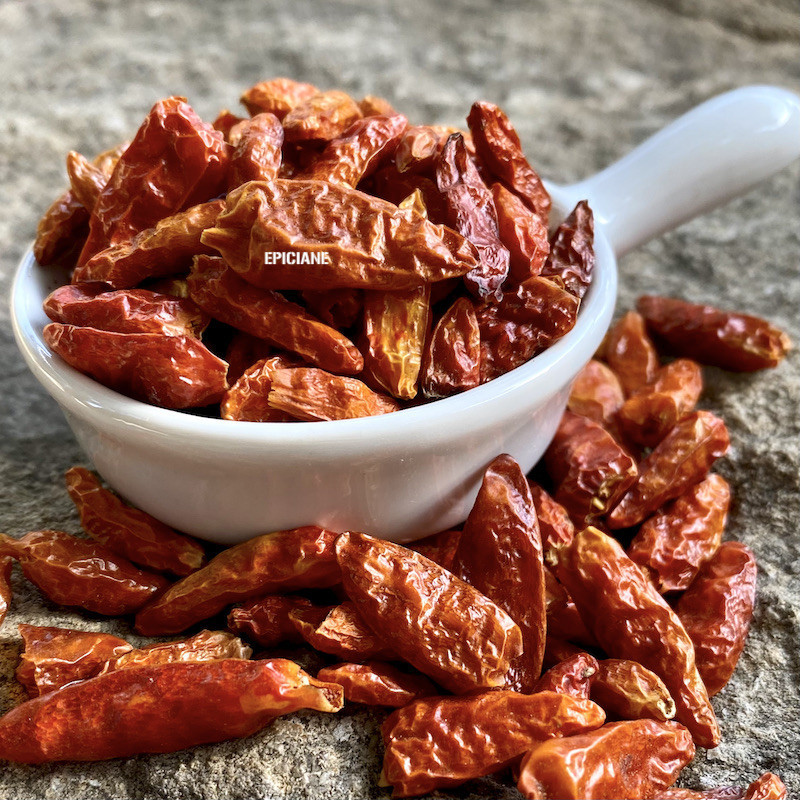
Reference: 30811001



It’s truly fiery, and that’s what we love about it!
It’s used to make spicy oils or to enhance all kinds of dishes: calamari, paellas, or shellfish broths.
 Delivery
Delivery
Mondial Relay
 Returns
Returns
See conditions
 Payments
Payments
100% secure
Livré en sachet refermable
Culinary Uses:
Cayenne pepper, also known as "bird's tongue," is simply fiery! Use it sparingly, but it brings a surprising, unique "pep" to nearly any savory dish in the world, and even to some sweet treats, as adventurous chefs sometimes incorporate it into chocolate—in small amounts, of course!
It’s particularly well-suited to ratatouilles, calamari, and shellfish dishes, and you’ll even find it in punch mixes!
Of course, it’s the key ingredient in spicy oils, commonly used on pizzas but also excellent for starting the cooking of many dishes, adding spice without making them overly hot. These oils are easy to make at home: use a simple olive oil base (olive oil captures flavors better than other oils) and let a handful of peppers steep in it, optionally with herbs. Allow at least 15 days of maceration, shaking occasionally.
Who Am I?
Origin: Uganda
Scientific Name: Capsicum annuum
Common Names: Cayenne pepper, hot pepper, bird's eye chili, pili-pili
Hot pepper belongs to the Solanaceae family, which includes all peppers as well as tomatoes and eggplants. All originate from Central and South America.
Although sometimes named after the city of Cayenne, this pepper isn’t cultivated there! It’s been grown for centuries in tropical climates worldwide.
If hot pepper is accidentally consumed, drinking water won’t help, as capsaicin—the compound responsible for its heat—is not water-soluble. Instead, milk should be consumed, as capsaicin binds to the milk protein casein, speeding up its elimination.
Interestingly, researchers have found that peppers “defend” themselves and become spicier when surrounded by more predators (insects or even parasitic fungi)!
Bird’s tongue pepper helps the body withstand extreme heat, a fact long known in the tropics. However, be careful not to touch your eyes or mucous membranes after handling it without washing your hands, as it can cause intense burning! Nonetheless, it has numerous health and digestive benefits when used in moderation.
In the West, it’s mainly used externally for arthritis and osteoarthritis pain relief.
Bird’s tongue pepper is also thought to have bactericidal properties, and consuming it in hot climates can significantly reduce the risk of intestinal infections.
A Bit of History:
Despite commonly being called "Cayenne pepper," this hot pepper doesn’t actually come from Cayenne! This name simply designates this variety of pepper.
The Aztecs called it "chili," a name that remains in English and German. For over 9,000 years, it was known to indigenous people in equatorial America, where it originated, for its culinary and medicinal properties.
A companion of Christopher Columbus introduced the plant to Europeans after his journey, intended for the Indies, actually ended in the Caribbean. The plant then quickly spread to equatorial regions around the globe and was adopted in Asia, the Middle East, and Africa.
Data sheet
Reference: 30811001
Reference: 021122
Reference: laurierE
Reference: 10814501
Reference: 00033663-0001
Reference: paprika
Reference: paprikafumé
Reference: 12M6951701
Reference: 508212501
Reference: 20813701
Reference: pilipili

It’s truly fiery, and that’s what we love about it!
It’s used to make spicy oils or to enhance all kinds of dishes: calamari, paellas, or shellfish broths.